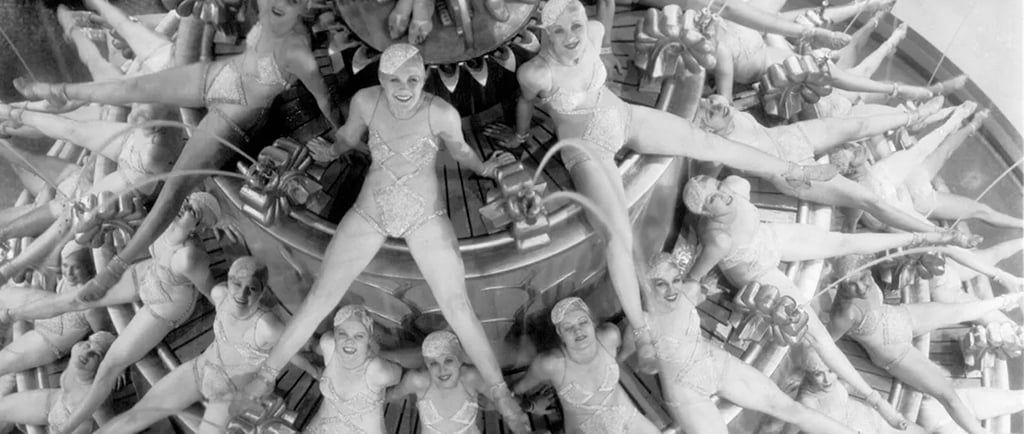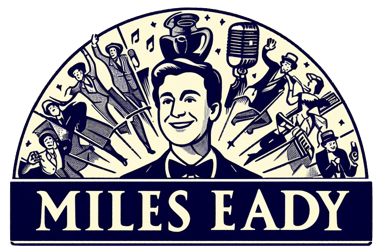A Timeline of Movie Musicals:
From Busby Berkeley to La La Land (1930s–Now)


Next in the series: Busby Berkeley and the Joy of Excess →
Welcome to this eight-part guide to the history of film musicals — a genre as bold, unpredictable and dazzling as the medium itself.
Whether you’re a seasoned chorus line fanatic or a curious newcomer who’s seen just one musical (is it La La Land?), this is your map through nearly a century of cinematic song and dance. Think of it as a theme park of musicals: over here, the whirling fountains of Busby Berkeley; over there, Fred and Ginger gliding through a Depression-era dreamscape. Ahead? Disney animations, jukebox revivals and the postmodern sparkle of the Pop Era.
Each post in this series dives into a different chapter of the film musical’s evolution — exploring the icons, styles and cultural shifts that defined it.
What Makes the Movie Musical So Unique?
The film musical is cinema’s most adaptable — and arguably most audacious — genre. It doesn’t merely evolve with the times; it reinvents itself, over and over again.
From frothy escapism to biting satire, Technicolor ballets to Broadway realism, and jukebox nostalgia to animated fairy tales, the musical absorbs whatever the moment demands — and adds a key change.
It’s this constant reinvention that keeps the genre alive. Just when it seems to vanish, it comes back louder, flashier or more ironic than ever.
The Eras of the Movie Musical — A Quick Map
Here's a bird’s-eye view of the key periods we’ll explore in detail:
The Dreams of Busby Berkeley (Early 1930s)
Kaleidoscopic, surreal, and sensual — choreographed spectacle shot from above. Think 42nd Street and Gold Diggers of 1933.
The Astaire–Rogers Era (1933–1939)
Charm and cheek-to-cheek elegance. Fred and Ginger glide through the Depression in Top Hat and Swing Time.
The Golden Age of Integration (1940s–1950s)
Songs drive character and story. MGM’s dream factory produces Singin’ in the Rain, Meet Me in St. Louis, and An American in Paris.
Stage-to-Screen Prestige (1950s–1960s)
Broadway hits go cinematic — from The Sound of Music to West Side Story and My Fair Lady.
tHE WOBBLE YEARS (1970s - 1980s)
Big flops meet bold experiments. Fosse’s Cabaret, Ken Russell’s Tommy, and cult hits like The Rocky Horror Picture Show redefine the form.
The Disney Renaissance (1990s)
Animated musicals rule again. From The Little Mermaid to The Lion King, this era teaches a new generation about “I Want” songs and villain reprises.
The Pop Era (2000s–Now)
Mixtape musicals go meta. From Moulin Rouge! to Glee, Chicago to La La Land, the genre becomes mash-up, memory, and commentary.
Want to Dive Deeper?
Start here with a few essential reads:
The Movie Musical! – Jeanine Basinger (2019)
A witty and encyclopedic tour of the genre, from 42nd Street to Chicago.
[Buy it here]The Hollywood Musical – Jane Feuer (1982)
An academic deep-dive into how musicals function as myth-making machines.
[Buy it here]Movie Musicals Trivia – Jeff Kurtti (1995)
A glittering compendium of fun facts and backstage tidbits.
[Buy it here]Must-See Musicals – Richard Barrios (2017)
The ultimate fan’s guide — joyful, opinionated, and full of love for the form.
[Buy it here]
Watch: Gene Kelly in Singin’ in the Rain (1952)
If you had to explain the movie musical in a single scene, you’d probably start here. Gene Kelly’s soaked, solo performance is more than a catchy title number — it’s a cinematic celebration of joy, movement and sheer exuberance. The choreography is masterful and natural, the grin is pure showbiz (he was dancing through a fever) and the whole thing reminds you why the musical didn’t need realism to tell the truth.
This version is hosted by TCM., so it should stick around — but YouTube has a funny way of making classics disappear. (Let me know if it breaks!)
Read the Next Post in the Series:
Whether you know your Top Hat from your Hairspray, or you’re just wondering what all the fuss is about, welcome aboard.
Next stop: Busby Berkeley — the man who turned chorines into chandeliers, and overhead shots into surrealist spectacles.
“Busby Berkeley and the Joy of Excess”
Or head straight to the world of Fred and Ginger:
“He Gives Her Class, She Gives Him Sex Appeal”

